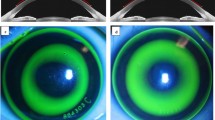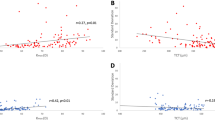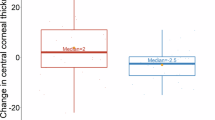Abstract
Purpose
To determine the intensity of corneal pigmented arc in orthokeratology (ortho-k)-treated children, and its correlation with key epithelial thickness measurements obtained by anterior segment optical coherence tomography (AS-OCT).
Methods
This study is a retrospective case series. Medical records of children who received ortho-k treatment for myopia control in our hospital were reviewed. Intensity of ortho-k-associated pigmented arc and its correlation with key epithelial thickness parameters in the central 7-mm-diameter zone obtained by AS-OCT was examined. The subjects were further divided into apparent and unapparent pigmented arc groups for severity comparison.
Results
The mean age of children was 11.4 years, and the incidence of corneal pigmented arc was 92.2% after lens wear for a mean duration of 21.2 months. Intensity of pigmented arc was found to be significantly correlated with key epithelial thickness parameters, including maximum and minimum epithelial thickness (Spearman’s rank correlation coefficient (rs) = 0.404, P = 0.003; rs = − 0.426, P = 0.002, respectively), the difference between them (Min–Max) (rs = −0.624, P < 0.001) and standard deviation (rs = 0.659, P < 0.001). Significant correlation between intensity of pigmented arc and ortho-k target power (rs = 0.454, P = 0.001) was found. Comparison between the two groups showed significant difference in the same key epithelial thickness parameters.
Conclusions
Children receiving ortho-k treatment tended to develop pigmented arcs. Significant correlation between intensity of pigmented arc and key epithelial thickness parameters was observed. AS-OCT can be a useful tool for predicting intensity of pigmented arc in ortho-k-treated children.
Similar content being viewed by others
Login or create a free account to read this content
Gain free access to this article, as well as selected content from this journal and more on nature.com
or
References
Liu YM, Xie P. The safety of orthokeratology–a systematic review. Eye Contact Lens. 2016;42:35–42.
Hiraoka T, Furuya A, Matsumoto Y, Okamoto F, Kakita T, Oshika T. Corneal iron ring formation associated with overnight orthokeratology. Cornea. 2004;23:S78–81.
Li X, Friedman IB, Medow NB, Zhang C. Update on orthokeratology in managing progressive myopia in children: efficacy, mechanisms, and concerns. J Pedia Ophthalmol Strabismus. 2017;54:142–8.
Chen C, Cheung SW, Cho P. Myopia control using toric orthokeratology (TO-SEE study). Invest Ophthalmol Vis Sci. 2013;54:6510–7.
Cho P, Cheung SW. Retardation of myopia in Orthokeratology (ROMIO) study: a 2-year randomized clinical trial. Invest Ophthalmol Vis Sci. 2012;53:7077–85.
Swarbrick HA, Wong G, O’Leary DJ. Corneal response to orthokeratology. Optom Vis Sci. 1998;75:791–9.
Kim WK, Kim BJ, Ryu IH, Kim JK, Kim SW. Corneal epithelial and stromal thickness changes in myopic orthokeratology and their relationship with refractive change. PLoS ONE. 2018;13:e0203652.
Chen D, Lam AK, Cho P. Posterior corneal curvature change and recovery after 6 months of overnight orthokeratology treatment. Ophthalmic Physiol Opt. 2010;30:274–80.
Tsukiyama J, Miyamoto Y, Higaki S, Fukuda M, Shimomura Y. Changes in the anterior and posterior radii of the corneal curvature and anterior chamber depth by orthokeratology. Eye Contact Lens. 2008;34:17–20.
Liang JB, Chou PI, Wu R, Lee YM. Corneal iron ring associated with orthokeratology. J Cataract Refract Surg. 2003;29:624–6.
Cho P, Chui WS, Mountford J, Cheung SW. Corneal iron ring associated with orthokeratology lens wear. Optom Vis Sci. 2002;79:565–8.
Gonzalez-Meijome JM, Gonzalez-Perez J, Garcia-Porta N, Diaz-Rey A, Parafita-Mato MA. Pigmented corneal ring associated with orthokeratology in Caucasians: case reports. Clin Exp Optom. 2012;95:548–52.
Barraquer-Somers E, Chan CC, Green WR. Corneal epithelial iron deposition. Ophthalmology. 1983;90:729–34.
Hiratsuka Y, Nakayasu K, Kanai A. Secondary keratoconus with corneal epithelial iron ring similar to Fleischer’s ring. Jpn J Ophthalmol. 2000;44:381–6.
Cho P, Cheung SW, Mountford J, Chui WS. Incidence of corneal pigmented arc and factors associated with its appearance in orthokeratology. Ophthalmic Physiol Opt. 2005;25:478–84.
Charm J, Cho P. High myopia-partial reduction ortho-k: a 2-year randomized study. Optom Vis Sci. 2013;90:530–9.
Hou W, Norton TT, Hyman L, Gwiazda J, Group C. Axial elongation in myopic children and its association with myopia progression in the correction of myopia evaluation trial. Eye Contact Lens. 2018;44:248–59.
Cho P, Chui WS, Cheung SW. Reversibility of corneal pigmented arc associated with orthokeratology. Optom Vis Sci. 2003;80:791–5.
Kim E, Ehrmann K. Assessment of accuracy and repeatability of anterior segment optical coherence tomography and reproducibility of measurements using a customised software program. Clin Exp Optom. 2012;95:432–41.
Li Y, Tan O, Brass R, Weiss JL, Huang D. Corneal epithelial thickness mapping by Fourier-___domain optical coherence tomography in normal and keratoconic eyes. Ophthalmology. 2012;119:2425–33.
Li Y, Tang M, Zhang X, Salaroli CH, Ramos JL, Huang D. Pachymetric mapping with Fourier-___domain optical coherence tomography. J Cataract Refract Surg. 2010;36:826–31.
Qian Y, Xue F, Huang J, Qu X, Zhou X, Lanen-Wanek DV. Pachymetry map of corneal epithelium in children wearing orthokeratology contact lenses. Curr Eye Res. 2014;39:263–70.
Yoon JH, Swarbrick HA. Posterior corneal shape changes in myopic overnight orthokeratology. Optom Vis Sci. 2013;90:196–204.
Acknowledgements
We acknowledge the financial support of the Maintenance Project of the Bio-statistical Consultation Center under Grant CLRPG2G0082 and thank the technicians of the Department of Ophthalmology, Chang Gung Memorial Hospital, Keelung for their technical assistance.
Author information
Authors and Affiliations
Corresponding author
Ethics declarations
Conflict of interest
The authors declare that they have no conflict of interest.
Additional information
Publisher’s note: Springer Nature remains neutral with regard to jurisdictional claims in published maps and institutional affiliations.
Rights and permissions
About this article
Cite this article
Liu, CF., Lee, JS., Sun, CC. et al. Correlation between pigmented arc and epithelial thickness (COPE) study in orthokeratology-treated patients using OCT measurements. Eye 34, 352–359 (2020). https://doi.org/10.1038/s41433-019-0542-8
Received:
Revised:
Accepted:
Published:
Issue Date:
DOI: https://doi.org/10.1038/s41433-019-0542-8



